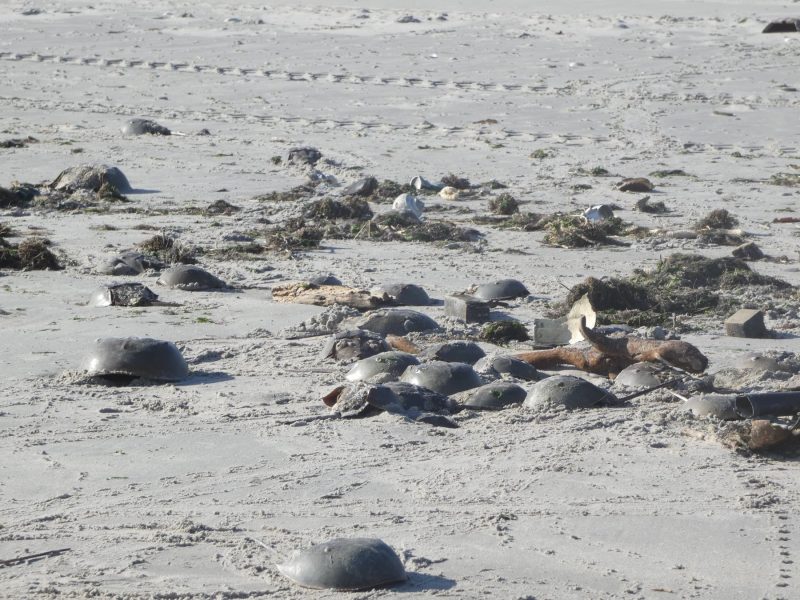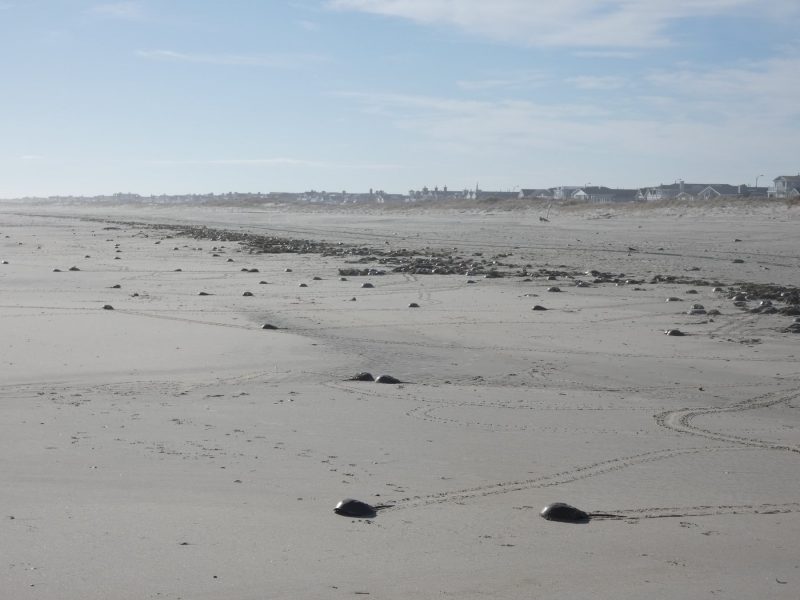A closeup of a horseshoe crab with shells attached to it.
 By MADDY VITALE
By MADDY VITALE
Linda Boris, of Mays Landing, enjoys walks along the beach in Ocean City once a week for the past six years. She especially likes the quieter months for her mini-excursions to the shore to take pleasure in nature and document it in photos.
But Wednesday around 1:30 p.m. when she took her weekly stroll, specifically down to 21st Street beach, she discovered something that was more Sci-Fi than nature channel.
“There was a tremendous sea of beached horseshoe crabs between 21st and 19th or so,” she said in an interview Thursday night. “Some were dead. Some were slowly working their way back to the ocean. Some were burrowing holes.”
Boris, 66, a retired healthcare worker with the U.S. Navy, attributed some the unusual sighting, in part, to a full moon, coupled with recent storms.
Horseshoe crabs are sea creatures that have been around for millions of years. They are most closely related to the arachnid family.

A closeup of a horseshoe crab with shells attached to it.
Like some of her more aesthetically pleasing finds, she took plenty of pictures.
“I had a new camera. I love taking pictures of birds and things. I walked down on 21st and there were people than usual on the beach for a cold day in January,” Boris explained. “A lot of things washed up and people were walking their dogs.”
Then she saw the long line of seaweed and in it, the horseshoe crabs – hundreds of them – she said.
“What was so cool is I have never seen them moving before. I saw all of the tracks in the sand they were making. A few were going to the water and some were burrowing. I have no idea why they were doing it,” Boris said, describing the scene. “Some were overturned. Some the tracks were in circles.”
Bob Schoelkopf, director of the Marine Mammal Marine Stranding Center in Brigantine, said he couldn’t be certain, that a dramatic change in water temperature could send the horseshoe crabs, as well as clams and crabs into a dormant state and they could be washed up by the current.
“They could be dormant on the beach, but they have to get back to into the water to stay alive,” he said.
While he doesn’t know how often the phenomenon occurs, he is notified each year about it.
“Every year we get called for horseshoe crabs, crabs and clams too, it is not uncommon. I think the reason people don’t see it as much is because most people don’t go on the beach when it is 10 degrees out,” he said, noting the cold-weather occurrences.

Some of the horseshoe crabs go back toward the water.
Schoelkopf said there is always the possibility that the storms created the clusters of horseshoe crabs washing ashore.
But he didn’t feel that was the likely case, more that cold temperatures put them in a dormant state and they moved up the beach with the tides.
For whatever reason Boris spend her afternoon walk photographing the prehistoric creatures, it was interesting to say the least, she said.
“It’s remarkable. I walk every week and I don’t see anything unusual,” she said. “Then there’s that one time when I was like, ‘Oh, wow.’ Definitely, it was something I had never seen before.”
She thought about turning some of the horseshoe crabs right side up to help them get back to the water.
Then she thought again. There were, after all, hundreds of them. She contacted someone from Fish and Wildlife about a fish she took a photo of earlier in the week.
“The person from Fish and Wildlife didn’t seem too concerned. He said they probably washed up with the storms,” Boris explained. “I would have needed a bulldozer to get them back in the water. There were a lot of them. Some of them were already making their way back. I just figured things happen after storms. They are prehistoric. They will be fine.”

Horseshoe crabs appear to wash up with a line of seaweed.
 By MADDY VITALE
Linda Boris, of Mays Landing, enjoys walks along the beach in Ocean City once a week for the past six years. She especially likes the quieter months for her mini-excursions to the shore to take pleasure in nature and document it in photos.
But Wednesday around 1:30 p.m. when she took her weekly stroll, specifically down to 21st Street beach, she discovered something that was more Sci-Fi than nature channel.
“There was a tremendous sea of beached horseshoe crabs between 21st and 19th or so,” she said in an interview Thursday night. “Some were dead. Some were slowly working their way back to the ocean. Some were burrowing holes.”
Boris, 66, a retired healthcare worker with the U.S. Navy, attributed some the unusual sighting, in part, to a full moon, coupled with recent storms.
Horseshoe crabs are sea creatures that have been around for millions of years. They are most closely related to the arachnid family.
By MADDY VITALE
Linda Boris, of Mays Landing, enjoys walks along the beach in Ocean City once a week for the past six years. She especially likes the quieter months for her mini-excursions to the shore to take pleasure in nature and document it in photos.
But Wednesday around 1:30 p.m. when she took her weekly stroll, specifically down to 21st Street beach, she discovered something that was more Sci-Fi than nature channel.
“There was a tremendous sea of beached horseshoe crabs between 21st and 19th or so,” she said in an interview Thursday night. “Some were dead. Some were slowly working their way back to the ocean. Some were burrowing holes.”
Boris, 66, a retired healthcare worker with the U.S. Navy, attributed some the unusual sighting, in part, to a full moon, coupled with recent storms.
Horseshoe crabs are sea creatures that have been around for millions of years. They are most closely related to the arachnid family.

 Some of the horseshoe crabs go back toward the water.
Schoelkopf said there is always the possibility that the storms created the clusters of horseshoe crabs washing ashore.
But he didn’t feel that was the likely case, more that cold temperatures put them in a dormant state and they moved up the beach with the tides.
For whatever reason Boris spend her afternoon walk photographing the prehistoric creatures, it was interesting to say the least, she said.
“It’s remarkable. I walk every week and I don’t see anything unusual,” she said. “Then there’s that one time when I was like, ‘Oh, wow.’ Definitely, it was something I had never seen before.”
She thought about turning some of the horseshoe crabs right side up to help them get back to the water.
Then she thought again. There were, after all, hundreds of them. She contacted someone from Fish and Wildlife about a fish she took a photo of earlier in the week.
“The person from Fish and Wildlife didn’t seem too concerned. He said they probably washed up with the storms,” Boris explained. “I would have needed a bulldozer to get them back in the water. There were a lot of them. Some of them were already making their way back. I just figured things happen after storms. They are prehistoric. They will be fine.”
Some of the horseshoe crabs go back toward the water.
Schoelkopf said there is always the possibility that the storms created the clusters of horseshoe crabs washing ashore.
But he didn’t feel that was the likely case, more that cold temperatures put them in a dormant state and they moved up the beach with the tides.
For whatever reason Boris spend her afternoon walk photographing the prehistoric creatures, it was interesting to say the least, she said.
“It’s remarkable. I walk every week and I don’t see anything unusual,” she said. “Then there’s that one time when I was like, ‘Oh, wow.’ Definitely, it was something I had never seen before.”
She thought about turning some of the horseshoe crabs right side up to help them get back to the water.
Then she thought again. There were, after all, hundreds of them. She contacted someone from Fish and Wildlife about a fish she took a photo of earlier in the week.
“The person from Fish and Wildlife didn’t seem too concerned. He said they probably washed up with the storms,” Boris explained. “I would have needed a bulldozer to get them back in the water. There were a lot of them. Some of them were already making their way back. I just figured things happen after storms. They are prehistoric. They will be fine.”
 Horseshoe crabs appear to wash up with a line of seaweed.
Horseshoe crabs appear to wash up with a line of seaweed.